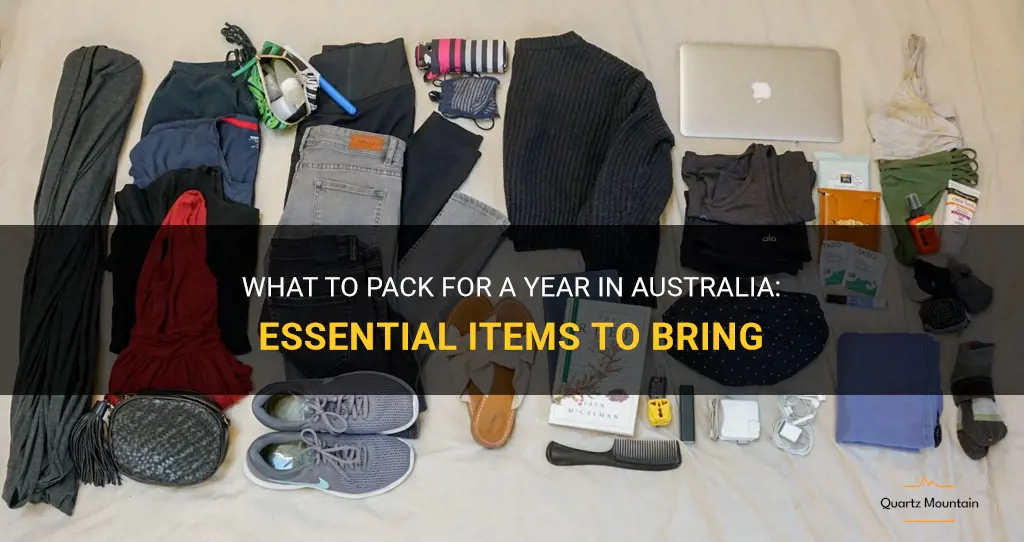
Planning a year-long adventure in Australia? From stunning beaches to vibrant cities and wild outback landscapes, this diverse country offers endless opportunities for exploration. But before you embark on your Australian journey, it's important to pack the right essentials to ensure a comfortable and enjoyable experience. In this guide, we'll highlight the key items you should bring with you when packing for a year in Australia, so you can make the most of your time down under.
What You'll Learn
- What are the essential items to pack for a year in Australia?
- Are there any specific clothing items or gear that are recommended for the different seasons in Australia?
- Are there any particular items that should be packed for specific activities or locations in Australia, such as camping or visiting the beaches?
- Are there any restrictions on what can be brought into Australia, such as certain foods or medications?
- What are some tips for packing efficiently and maximizing luggage space for a year in Australia?

What are the essential items to pack for a year in Australia?
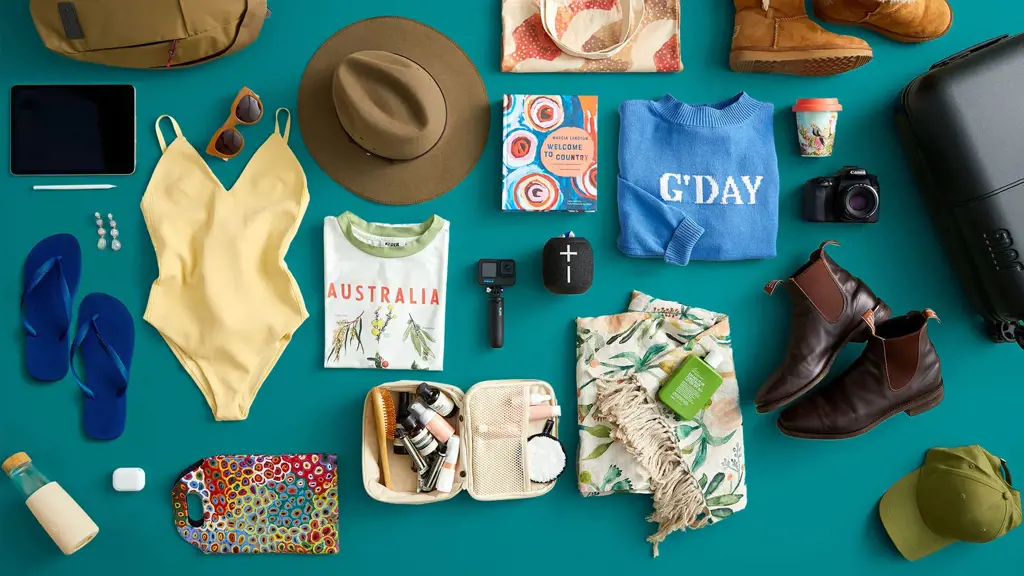
Planning a year-long trip to Australia? That's exciting! With its diverse landscapes, lively cities, and unique wildlife, Australia is a dream destination for many travelers. But before you embark on your adventure, it's important to plan and pack accordingly. Here are some essential items you should consider bringing along for your year in Australia:
- Clothing: Australia experiences different climate zones, so pack clothing suitable for all seasons. In the summer, lightweight and breathable clothing, along with a hat and sunscreen, will help protect you from the sun's harsh rays. For the cooler months, consider packing layers, such as sweaters and jackets, as temperatures can drop, especially in southern areas.
- Travel documents: Don't forget to bring your passport, visa, and any other necessary travel documents. It's also a good idea to make copies and store them separately in case of loss or theft. If you plan to drive in Australia, an international driver's license is a must.
- Electronics and adapters: Australia uses Type I power sockets, so make sure to bring the appropriate power adapters for your devices. Additionally, a universal power strip can be handy to charge multiple devices at once.
- Healthcare essentials: Australia has excellent healthcare facilities, but it's still important to pack any prescription medications you need for the duration of your stay. If you wear glasses or contacts, bring an extra pair or a copy of your prescription. Don't forget travel insurance, as it will provide coverage in case of any unforeseen medical emergencies.
- Outdoor gear: Australia is renowned for its stunning nature and outdoor activities. If you plan to explore national parks or go hiking, pack sturdy shoes, a backpack, a water bottle, a hat, and insect repellent. A good quality camera will also come in handy to capture the epic landscapes and wildlife encounters.
- Money and banking: Although credit cards are widely accepted, it's always handy to carry some cash for smaller establishments or emergencies. Notify your bank about your travel plans to ensure your card isn't blocked while you're in Australia. Consider opening an Australian bank account if you plan to work or stay for an extended period.
- Toiletries and personal items: Pack your preferred toiletries, as you may not find the exact brands in Australia. Sunscreen, mosquito repellent, and a first aid kit are also essential. Don't forget to bring any necessary prescription glasses, contact lenses, or other personal items you need on a regular basis.
- Entertainment and communication: Long flights and downtime during your trip may be more enjoyable with some entertainment options. Bring books, magazines, or download movies and music to your devices. A portable charger or power bank will ensure your devices stay charged throughout your journey.
Remember, this is just a general list, and your specific needs may differ depending on your travel plans and personal preferences. It's always a good idea to research the specific regions you'll be visiting in Australia to ensure you're adequately prepared for the local climate and activities.
In conclusion, packing for a year in Australia requires thoughtful planning. By considering the climate, activities, and specific needs, you can ensure a comfortable and enjoyable experience throughout your journey. Bon voyage!
The Ultimate Guide on What to Pack for Glamping
You may want to see also

Are there any specific clothing items or gear that are recommended for the different seasons in Australia?

When it comes to dressing for the different seasons in Australia, it is important to consider the specific climate and weather conditions of each region. Australia experiences a diverse range of climates, ranging from tropical in the north to temperate in the south. As a result, the clothing and gear recommended for each season can vary greatly.
In the summer months, Australia can be extremely hot, particularly in the northern parts of the country. Lightweight and breathable clothing is essential to help keep cool and prevent heat exhaustion. Loose-fitting cotton or linen clothing is recommended, as these fabrics allow air to circulate and absorb sweat. Additionally, it is important to protect yourself from the harsh Australian sun by wearing a wide-brimmed hat, sunglasses, and sunscreen.
In the southern parts of Australia, where the climate is more temperate, summer can still be hot but may also experience cooler evenings. Layering is key in these regions, as it allows you to adjust your clothing as the temperature fluctuates throughout the day. Light sweaters or cardigans can be worn over a t-shirt or tank top in case the temperature drops.
As autumn approaches, the weather starts to cool down across the country. In the north, the transition from summer to autumn may not be as noticeable, but in the south, the days become shorter and cooler. It is recommended to start layering with lightweight jackets or vests, as well as long-sleeved shirts or blouses. In regions where the weather is more distinct, you may also need a light jacket and closed-toe shoes for the cooler evenings.
Winter in Australia varies significantly depending on the region. In the northern parts of the country, winter may still be relatively warm, while in the southern regions, it can be quite cold. It is important to check the average temperatures and weather conditions for your specific location. In general, warmer clothing is required during this season, including sweaters, coats, scarves, and gloves. Layering is once again key, as it allows you to add or remove clothing as needed.
Spring in Australia is a time of transition, as the weather starts to warm up again after winter. Lighter layers can be worn during this season, including t-shirts, long-sleeved shirts, and lightweight jackets. It is important to keep in mind that spring can also bring unpredictable weather, with the possibility of both warm and cool days. Be prepared with a mix of clothing options that can be easily layered or removed as needed.
In addition to clothing, it is important to consider the appropriate footwear for each season. In the summer, breathable sandals or sneakers are recommended, while in the cooler months, closed-toe shoes or boots provide better protection from the elements.
To sum up, the clothing and gear recommended for each season in Australia will vary depending on the specific climate and region. It is essential to consider the average temperatures, weather conditions, and your own personal comfort when selecting clothing items and gear. Layering is often the key to staying comfortable throughout the year, as it allows you to adjust your clothing as the weather changes. By being prepared and dressing appropriately, you can fully enjoy the beauty of each season in Australia.
Essential Items to Pack for a Day at Six Flags
You may want to see also

Are there any particular items that should be packed for specific activities or locations in Australia, such as camping or visiting the beaches?
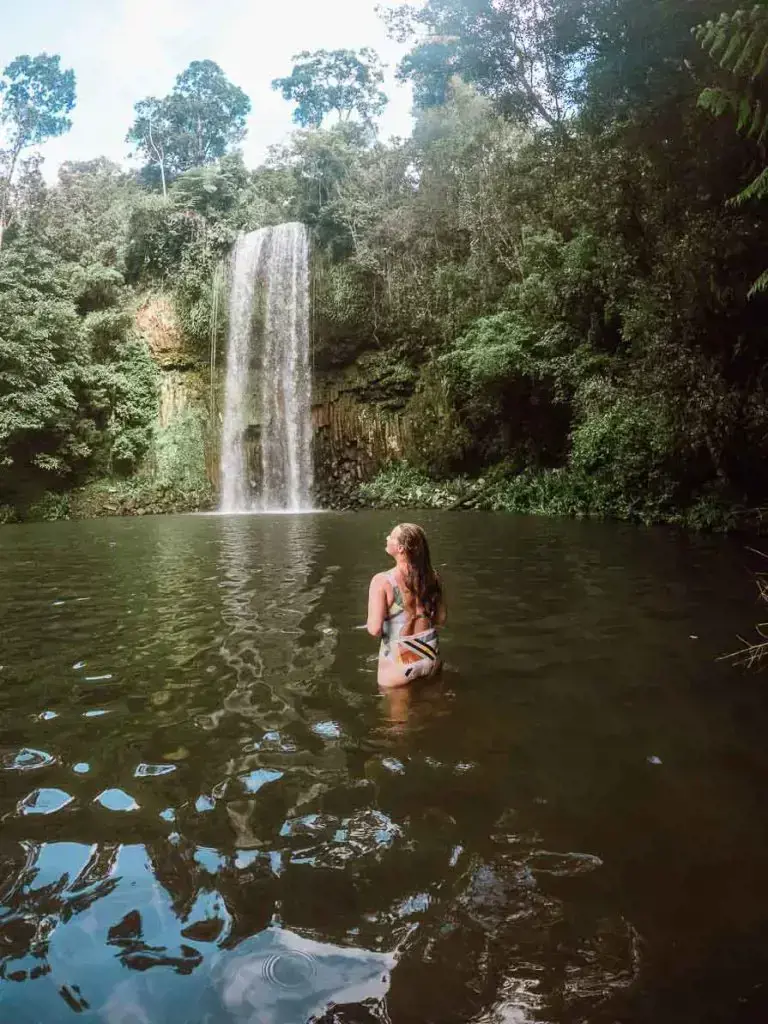
When planning a trip to Australia, it is important to pack the right items for the various activities and locations you will be visiting. Australia is a diverse country with a wide range of landscapes, from stunning beaches to remote camping spots. Here are some essential items that you should consider packing for specific activities or locations in Australia.
Camping:
If you are planning to go camping in Australia, it is essential to have the right gear to ensure a comfortable and enjoyable experience. Some items to consider packing include:
- Tent: A sturdy tent is a must-have for camping in Australia. Look for a tent that is easy to set up and provides enough space for your group.
- Sleeping bag: Pack a sleeping bag that is suitable for the climate you will be camping in. Australia has varying temperatures, so choose a sleeping bag that can handle both hot and cold weather conditions.
- Camping stove: Cooking equipment such as a camping stove and cookware is essential for preparing meals while camping. Make sure to pack fuel canisters and cooking utensils as well.
- Insect repellent: Australia is known for its outdoor insects, including mosquitoes and flies. It is important to pack insect repellent to protect yourself from bug bites.
- First aid kit: Accidents can happen while camping, so it is crucial to have a well-stocked first aid kit. Include items such as bandages, antiseptic ointment, and pain relievers.
Beach:
With its stunning coastline, Australia is famous for its beautiful beaches. When visiting the beaches, there are a few essential items to pack for a fun day by the water.
- Sunscreen: The Australian sun can be intense, so it is essential to pack sunscreen with a high SPF to protect your skin from harmful UV rays.
- Hat and sunglasses: A wide-brimmed hat and a pair of sunglasses will provide additional protection from the sun. Look for sunglasses with UV protection to shield your eyes.
- Swimwear: Of course, you can't forget to pack your swimwear for a day at the beach. Choose a comfortable and stylish swimsuit that suits your preferences.
- Beach towel: A large, absorbent towel is essential for drying off after swimming or lounging on the beach. Quick-drying microfiber towels are a popular option for beachgoers.
- Beach toys: If you are traveling with children, consider packing some beach toys such as buckets and spades to keep them entertained in the sand.
Hiking:
Australia is home to many stunning hiking trails, so if you plan to explore the great outdoors, here are some items to consider packing for your hike.
- Sturdy hiking shoes: Invest in a good pair of hiking shoes or boots that provide excellent traction and ankle support. This will help you navigate uneven terrain and protect your feet from injuries.
- Backpack: A comfortable backpack with a hydration system or compartments for water bottles is essential for carrying water, snacks, and other hiking essentials.
- Lightweight clothing: Dress in lightweight, moisture-wicking clothing that is suitable for the weather conditions. Layering is essential, as temperatures can change rapidly in some parts of Australia.
- Navigation tools: Carry a map, compass, or GPS device to ensure you stay on the right trail. Familiarize yourself with the route before setting off on your hike.
- Water and snacks: Stay hydrated and energized by packing plenty of water and snacks. Remember to refill your water bottles at available water sources along the trail.
These are just a few examples of the items you should consider packing for specific activities or locations in Australia. The key is to plan ahead and pack according to the activities you will be participating in and the specific conditions you will encounter. By doing so, you can ensure a safe and enjoyable trip to Australia.
Essential Items to Pack in a Bug Out Bag for Emergencies
You may want to see also

Are there any restrictions on what can be brought into Australia, such as certain foods or medications?
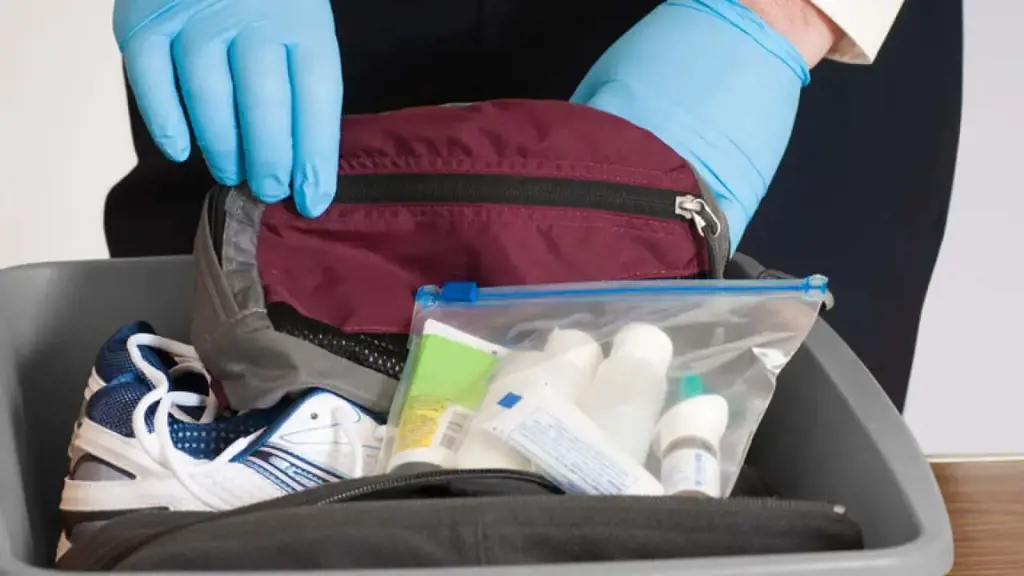
Yes, there are strict rules and regulations regarding what can be brought into Australia. This is primarily done to protect the country's unique ecosystems and prevent the introduction of pests and diseases that could harm local agriculture, wildlife, and human health.
When it comes to food, Australia has one of the strictest biosecurity systems in the world. Many types of food items are either completely prohibited or require special permits and documentation for import. This includes fresh fruits and vegetables, meat and meat products, dairy products, and various other animal and plant-based products. The reason for such restrictions is to prevent the introduction of pests and diseases that could devastate Australia's agricultural industry.
Similarly, there are restrictions on medications and other therapeutic goods brought into Australia. The Australian government has a regulatory agency called the Therapeutic Goods Administration (TGA), which oversees the import, supply, and use of medications and medical devices. Before bringing any medication into the country, it is essential to ensure that it is legally permitted and that the necessary paperwork is completed.
In addition to food and medications, there are also restrictions on bringing certain biological materials into Australia. This includes items such as live animals, animal products, plant materials, and biological samples. Importing these materials may require permits, quarantine inspections, and compliance with specific regulations to prevent the entry of diseases and pests.
To ensure compliance with these restrictions, it is essential for travelers to familiarize themselves with the Australian Department of Agriculture, Water, and the Environment's guidelines for importing goods. The department provides comprehensive information on prohibited and restricted items, as well as the necessary permits and documentation required for certain items.
Penalties for non-compliance with these regulations can be severe, including fines and even imprisonment. Therefore, it is crucial to carefully consider what you are bringing with you before traveling to Australia and to declare any restricted items at customs upon arrival.
In conclusion, there are restrictions on what can be brought into Australia, including certain foods, medications, and biological materials. These restrictions are in place to protect the country's unique ecosystems, agricultural industry, and public health. It is vital for travelers to familiarize themselves with the guidelines and regulations and ensure compliance to avoid any legal repercussions.
The Ultimate Guide to Packing for a Relaxing Resort Vacation
You may want to see also

What are some tips for packing efficiently and maximizing luggage space for a year in Australia?
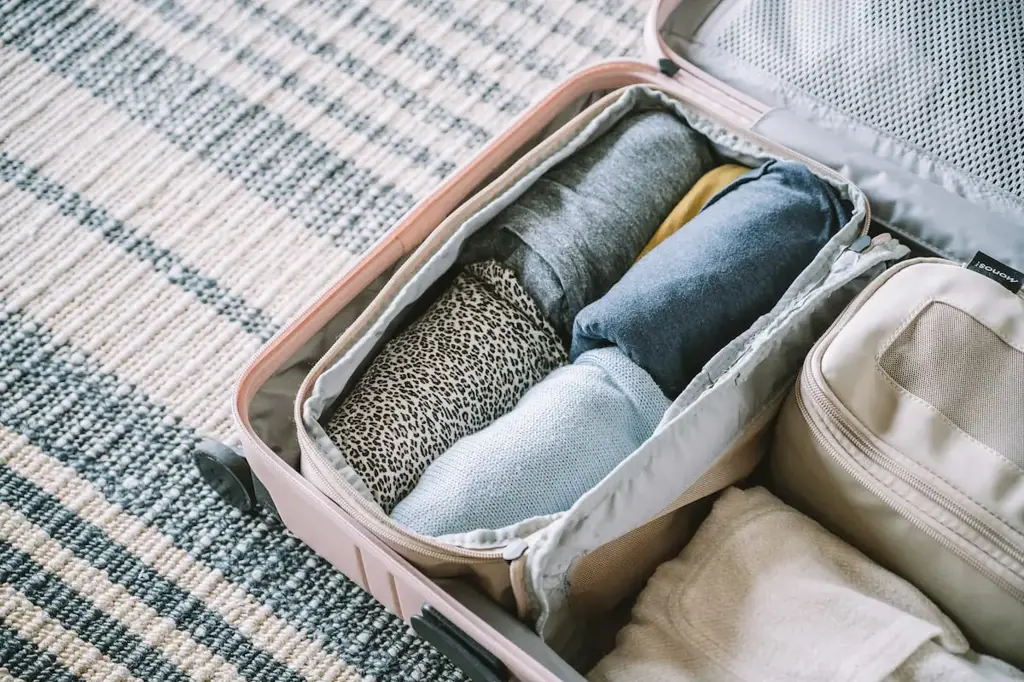
When preparing for a year-long trip to Australia, efficient packing and maximizing luggage space are essential. Here are some tips to help you pack effectively and make the most out of your limited luggage space.
- Make a packing list: Start by making a comprehensive list of all the items you will need during your year in Australia. Categorize the items into clothing, toiletries, electronics, and miscellaneous. This will help you stay organized and ensure you don't forget anything important.
- Choose versatile clothing: Opt for clothing items that can be easily mixed and matched to create multiple outfits. Stick to neutral colors and pack items that can be layered for different weather conditions. Remember, it's better to pack lighter and do laundry more frequently than to pack excessive clothing.
- Rolling technique: Instead of folding your clothes, roll them tightly to save space. Rolling not only compresses your clothes but also helps prevent wrinkles. This technique allows you to fit more items into your luggage without taking up too much space.
- Utilize vacuum bags: Vacuum-sealed bags can be a game-changer when it comes to maximizing luggage space. Pack your clothes in these bags and use a vacuum cleaner to remove excess air. This drastically reduces the overall size of your clothing and creates more room in your luggage.
- Pack travel-sized toiletries: Purchase travel-sized toiletries or transfer your favorite products into smaller containers. This will not only save space but also comply with airline regulations. Remember to pack only the essentials and avoid duplicates or items that can easily be purchased once you arrive in Australia.
- Wear bulky items on the plane: If you have larger or bulkier items such as heavy jackets or hiking boots, wear them on the plane instead of packing them in your luggage. This frees up space and ensures you don't exceed weight restrictions for checked-in baggage.
- Use packing cubes: Packing cubes are a great organizational tool that helps maximize luggage space. These cubes come in various sizes and allow you to compartmentalize your belongings. This not only saves space but also makes it easier to find specific items without having to unpack everything.
- Leave room for souvenirs: Keep in mind that you'll likely be bringing back souvenirs from your year in Australia. Leave some extra space in your luggage to accommodate these items. It's a good idea to pack a collapsible duffle bag or tote that can be used as an extra bag for the return journey.
By following these tips, you can pack efficiently and maximize your luggage space for a year in Australia. Remember to be mindful of weight restrictions and only pack the essentials. With careful planning and organization, you can have a stress-free journey and make the most out of your trip Down Under.
Essential Items to Pack for Boston in October
You may want to see also
Frequently asked questions
When packing for a year in Australia, it is important to consider the climate and activities you will be participating in. The country has a varied climate, so pack a mix of clothing for both warm and cold weather. Don't forget to pack swimwear, as Australia is famous for its beautiful beaches. Additionally, bring a comfortable pair of walking shoes for exploring cities and national parks.
Australian summers can be hot and sunny, so it is essential to pack sun protection. Bring lightweight, breathable clothing, a wide-brimmed hat, sunglasses, and sunscreen with a high SPF. It is also a good idea to pack a reusable water bottle to stay hydrated.
While Australia's winters are generally mild in comparison to other countries, it can still get chilly, especially in southern regions. Pack a mix of both warm and lightweight clothing, such as sweaters, jackets, long-sleeved shirts, and pants. Don't forget to bring a pair of closed-toe shoes or boots for cooler days.
Australia is known for its outdoor activities, so be sure to pack appropriate gear. If you plan on hiking or camping, bring sturdy hiking boots, a waterproof jacket, a backpack, and a sleeping bag. If you plan on engaging in water sports, such as surfing or snorkeling, pack a wetsuit or rash guard.
In addition to clothing and gear, there are a few other essential items you should pack for a year in Australia. These include a universal power adapter to charge your electronic devices, a mosquito repellent for protection against insects, a first aid kit in case of emergencies, and any necessary medications. It is also a good idea to have travel insurance to ensure you are covered in case of any unforeseen circumstances.







